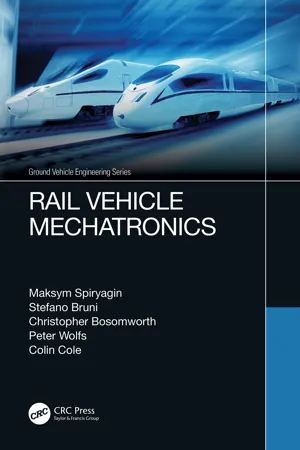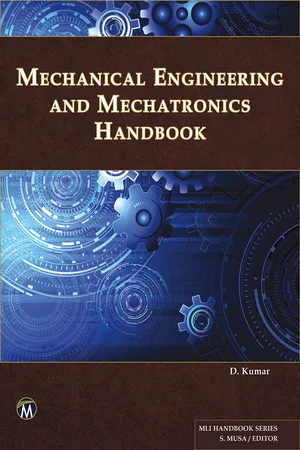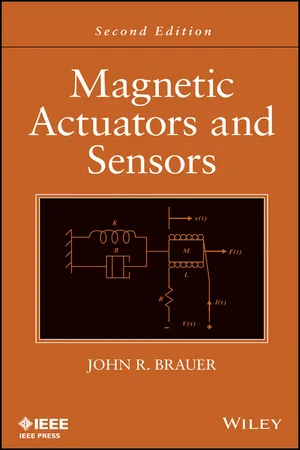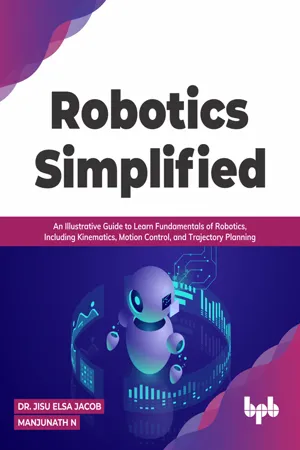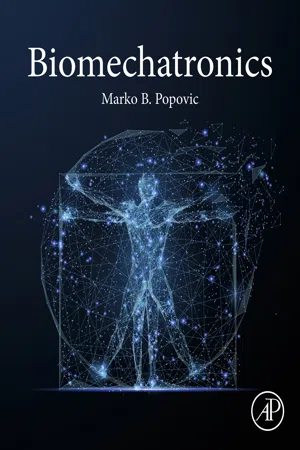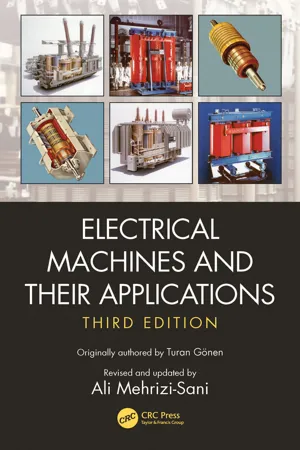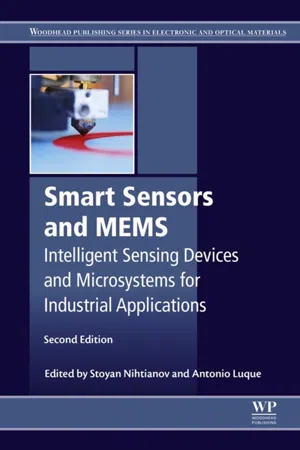Physics
Electromechanical Actuators
Electromechanical actuators are devices that convert electrical energy into mechanical motion. They are commonly used in various applications such as robotics, aerospace systems, and industrial machinery. These actuators typically consist of an electric motor, a transmission system, and a mechanism to convert rotary motion into linear motion, allowing for precise control and movement.
Written by Perlego with AI-assistance
10 Key excerpts on "Electromechanical Actuators"
- eBook - ePub
- Maksym Spiryagin, Stefano Bruni, Christopher Bosomworth, Peter Wolfs, Colin Cole(Authors)
- 2021(Publication Date)
- CRC Press(Publisher)
In general, an electro-mechanic actuator consists of an electric motor and of a mechanical transmission providing the interface of the motor to the plant. The electric motor is controlled using a feedback control loop in which the controlled variable can be either a force or a measured displacement/rotation representative of the system's position. A controlled electric motor is termed a servomotor. Recent developments of power electronics have made the control of servomotors much simpler than previously, removing some of the limitations associated with the different typologies of electric motors. Electro-mechanical actuators are typically composed by a servomotor coupled to a mechanical transmission which provides a suitable interface of the servomotor to the plant. In particular, the mechanical transmission may include: A ball screw and nut device to convert the rotation of the output shaft of the servomotor into a linear movement. A gear train to amplify the torque generated by the servomotor by means of a suitable gear ratio. Advantages of electro-mechanical actuators are the compact design with high force density, accurate and fast actuation, high efficiency, no risk of fluid leakage/contamination which is otherwise possible for hydraulic actuators. However, Electromechanical Actuators also have significant drawbacks, namely: risk of jamming due to failures in the mechanical transmission, relatively high cost, high stiffness at high frequency - eBook - ePub
Mechatronic Systems, Sensors, and Actuators
Fundamentals and Modeling
- Robert H. Bishop(Author)
- 2017(Publication Date)
- CRC Press(Publisher)
Converting electrical energy to mechanical energy is the common thread among different Electromechanical Actuators. Physics provided us with many different mechanisms either through direct conversion such as piezoelectric or through an intermediate medium such as a magnetic field. We will present an overview of the more common Electromechanical Actuators by their energy conversion mechanism: electromagnetic, electrostatic, and piezoelectric. The following discussion is intended to provide introductory information about the types of electromechanical actuation and is by no means exhaustive. Detailed discussion of each can be found in subsequent chapters, where they will be discussed in more detail.21.1.2.1 Electromagnetics—Magnetic FieldElectromagnetic is the most widely utilized method of energy conversion for Electromechanical Actuators. One of the reasons for using magnetic fields instead of electric fields is the higher energy density in magnetic fields. The air gap that separates a stationary member (stator) and a moving member of an electromechanical actuator is where the electromechanical energy conversion takes place. The amount of energy per unit volume of air gap for magnetic fields can be five orders of magnitude higher than that of electric fields.Lorentz’s law of electromagnetic forces and Faraday’s law of electromagnetic induction are the two fundamental principles that govern electromagnetic actuators. Before going into the detail of electromagnetics, we will first introduce the concept of magnetic field and flux.Magnetic flux ϕ exists due the presence of a magnetic field. The magnetic field strengthH →(in A/m) and the magnetic flux densityB →(in tesla [T]) are related by the permeability of the material. In a vacuum, the magnetic flux density is directly proportional to the magnetic field strength and is expressed byB →=μ 0.H →(21.1) where μ0 = 4[T m/A] is the permeability constant - eBook - ePub
Control of Mechatronic Systems
Model-Driven Design and Implementation Guidelines
- Patrick O. J. Kaltjob(Author)
- 2020(Publication Date)
- Wiley(Publisher)
In this chapter, classical models of electrical-driven actuating systems, along with the dynamics of their associated transmission element dynamics, are presented. Some process models involving various transmission elements are described, in order to illustrate their real-life applications. In addition to electrical-driven actuator characterization, sensor types and measuring principles are covered. Dynamic characterizations are presented for various physical system variables such as linear and rotational position, speed, acceleration, force, torque, chemical content, distance, flow, temperature, proximity, level, and pressure. In addition, signal conditioning principles and categorization (zero-, first-, second-order sensors, etc.), sensor and detector design specifications, and device characteristics such as linearity, sensitivity, limitations, calibration, and saturation are detailed. Finally, the sensing and operating principles of dynamic sensors such as the dynamics model, time domain, and frequency response characteristics are developed.8.2 Actuators in Mechatronics
Electric actuators can generate either a binary output signal (i.e. contact relay) or continuous signal (stepper motor). Such electrical-driven actuating systems can be classified based on their electrostatic or electromagnetic – and even electrothermal – design principles. Their coupled transmission elements generate force to motion, pressure to flow, heat, and so on. Recent advances in nanotechnologies have led to the development of low-scale actuators (nano or micro).Electromechanical Actuators usually operate based on the electrostatic (electrostatic actuators) or the electromagnetic (electromagnetic actuators) principle. Electrostatic actuators use charged particle motion within the induced field to generate adequate force, vibration, pressure, and temperature variation displacement of a membrane or beam. They include piezo-electric actuators, which deliver strain-based actuation from piezo-materials by generating a voltage proportional to the applied mechanical deformation. Such piezo-materials use either ceramics (i.e. lead-zirconate-titanate) or polymers (i.e. polyvinylidene fluoride). Surrounded by electrodes or attached to them they allow strain-based actuation of up to a few kilovolts per millimeter. Among micro-device applications are: (i) position systems, such as micromanipulation (microrobot with piezo-legs), vibration oscillation suppression systems, valves (micro-pumps in artificial hearts), and ultrasonic motors; and (ii) handling systems, such as microgrippers and laser printers (which use charged particles from the toner, which move based on the electrophotographic principle). - eBook - ePub
- D. Kumar, Sarhan M. Susa(Authors)
- 2022(Publication Date)
- Mercury Learning and Information(Publisher)
10ACTUATION AND ACTUATING SYSTEMS10.1. ACTUATOR AND ACTUATIONAn actuator is an energy conversion device that makes some things move or operate. Essentially it uses a form of power/energy to convert a control signal into mechanical motion, and the process of energy conversion to mechanical form is called actuation .The actuators are encountered at house and at workplace. For example:● automatic opening of the door when a person enters a grocery shop, and● forward or backward movement of a car seat.Actuators are located in from electric door locks in automobiles to ailerons in air-crafts. Industrial plants use actuators to operate valves, dampers, fluid couplings, etc.Actuators are classified by the type of motion and the power source. Linear actuators produce pull or push action and the linear motion may be along with one or more of the three axes X–X axis, Y–Y axis, and Z–Z axis.FIGURE 10.1 Types of motionThe rotational motion is the motion of a rigid body along with one or more of the three-axis along the X-X axis, Y-Y axis, and Z-Z axis.Depending upon the power source, actuators are categorized as:● Electromechanical Actuators: These actuators use AC, DC, or stepper electric motors to convert electrical energy into mechanical work.● Fluid power actuators: These actuators use fluid energy that is transmitted through a fluid under pressure. The fluid used is a liquid (water or oil) in a hydraulic actuator and compressed air or some inert gas in a pneumatic actuator.● Active material-based actuators: - eBook - ePub
- John R. Brauer(Author)
- 2014(Publication Date)
- Wiley-IEEE Press(Publisher)
PART II ACTUATORSPassage contains an image CHAPTER 7 Magnetic Actuators Operated by DC
Magnetic actuators use magnetic fields to transform electrical energy into mechanical energy. Thus they are a type of transducer , which is any device that transforms one type of energy into another [1]. However, the mechanical motion of the magnetic actuators in this book is over a limited range of motion. This limited range is commonly assumed for actuators, unlike electric motors and other rotary electromagnetic machines, which have large unlimited motion over multiple revolutions. This part of the book, Part II, is devoted to magnetic actuators.This chapter discusses in detail the most common types of magnetic actuators operated by direct current, in the following order: solenoid actuators, voice coil actuators, other linear actuators, proportional actuators, rotary actuators, magnetic bearings and couplings, and magnetic separators.7.1 SOLENOID ACTUATORSSolenoid actuators have a solenoidal coil , which is a coil of wire wound to a shape that is sometimes cylindrical. All solenoid actuators also have a steel armature , a term for the moving part. In solenoid actuators, the armature moves along a straight line and thus produces linear motion . A common use of solenoid actuators is to move a mechanical switch for large voltages and currents. Since the current supplied to the solenoid coil is much smaller than the current being switched, the solenoid and switch form a relay or contactor.7.1.1 Clapper ArmatureA solenoid actuator with a clapper armature functions similar to a clapping hand. The armature acts like one hand that is drawn by a magnetic force to the second hand. Because the second “hand” is stationary, it is called the stator.Like a clapping hand, the clapper armature usually contacts the stator at two areas. In one area, magnetic flux enters the armature, while it leaves the armature through the other area, producing useful magnetic force over both areas. Since magnetic flux must always both enter and leave the armature (or any other volume as discussed in Chapter 1), the clapper armature is often more compact than other designs. The clapper may be either flat, like a flat hand, or may have ridges, like a cupped hand. - eBook - ePub
Electrical Energy Conversion and Transport
An Interactive Computer-Based Approach
- George G. Karady, Keith E. Holbert(Authors)
- 2013(Publication Date)
- Wiley-IEEE Press(Publisher)
6 Electromechanical Energy ConversionElectromechanical energy conversion is employed in several devices designed by electrical engineers. In many cases, the energy conversion requires the assistance of a magnetic or electric field. Devices using electromechanical energy conversion are categorized as:- Transducers that convert another energy form into a signal; typical examples are microphones, loudspeakers, sensors, and electrical pickups;
- Actuators that utilize an electrical signal to move or control another device; these include relays, solenoids, and electromagnets; and
- Continuous energy conversion equipment such as motors and generators.
This chapter addresses the principles of electromechanical energy conversion and presents the major equations used for analyzing the operation of different devices. The practical application of the principles is demonstrated through the analysis of actuator operation. Transducers and actuators can also be constructed of piezoelectric (PE) materials that generate charge when they are strained. Continuous energy conversion equipment like motors and generators are detailed later in this book. First, magnetic circuit analysis is detailed in order to provide a working knowledge of the coupling of electromagnetic fields.6.1. Magnetic Circuits
Electric power equipment, such as transformers, generators, and motors, as well as appliances, have magnetic components and use magnetic coupling for energy transfer. This necessitates the study of magnetic circuits. The typical magnetic circuit contains a laminated iron core with one or more windings. The magnetic property of the iron core is described by the B-H curve, which gives the flux density (B) and magnetic field intensity (H) relation, as graphed in Figure 6.1 - eBook - ePub
Robotics Simplified
An Illustrative Guide to Learn Fundamentals of Robotics, Including Kinematics, Motion Control, and Trajectory Planning (English Edition)
- Dr. Jisu Elsa Jacob, Manjunath N(Authors)
- 2022(Publication Date)
- BPB Publications(Publisher)
HAPTER 4Robotic Drive Systems and Actuators
Introduction
Actuators are the muscles of the robot that drive the robot. They allow the robot to move. Actuators are the transducers that convert the energy from the source to linear or rotary motion of robots. An actuator can be defined as a device that can mechanically drive a dynamic system. A motor is an example for an actuator in a robotic manipulator.One of the major steps in designing a robot or an engineering system is to properly select the drive system or actuator based on various considerations. A typical actuator consists of major mechanical parts like cylinders, coils, rotors, shafts, bearings, etc., along with its electronic components for their control. Thus, proper design, manufacture, and proper operation of these two classes of components are crucial for ensuring highly efficient operation of an actuator.Structure
In this chapter, we will discuss the following topics:- Need for actuators in robotics
- Various types of actuators
- Electric motors and various types
- Hydraulic actuators
- Pneumatic actuators
- Linear actuators
Objectives
The main objective of this chapter is to introduce the basic concept and significance of actuators in the field of robotics. This chapter explains in detail the various types of actuation and drive systems and the various types of electric motors used in actuation. It also describes the various blocks in hydraulic and pneumatic actuation systems. Additionally, the comparison of advantages as well as disadvantages of various actuation systems and their principles of operation are also discussed. The methods of speed control and direction control of motors are also included in the chapter.Introduction to actuators
Actuators enable the movement of robot joints and enable the robot arm and grippers to move and perform tasks. Like muscles, they give the power to the joints to make proper movements as per the design. The commonly used actuators are electric actuators, hydraulic actuators, and pneumatic actuators based on the source from which power is obtained, that is, electricity, compressed fluid, and pressurized air, respectively. - eBook - ePub
- Marko B. Popovic(Author)
- 2019(Publication Date)
- Academic Press(Publisher)
Nonbiological actuators are mechanical, electrical, or electromechanical systems that produce linear or rotary motions. Actuators convert some form of energy, electrical or mechanical, to mechanical work. Nonbiological actuators are classified primarily by the type of motion produced. Linear actuators convert energy into translational motion while rotary actuators convert energy to rotational motion. The outputs from a linear actuator are force and displacement while the outputs from a rotational actuator are torque and angular displacement.In addition to the classification by the type of motion produced, actuators can also be classified by the type of medium used to supply energy to the system or the basic design configuration of the actuator. Both linear and rotary actuators can utilize pneumatic, hydraulic, or electrical energy to generate actuation. Electrical energy is the most common energy source although hydraulic oil or compressed air can be used to transfer energy to hydraulic or pneumatic actuators, respectively.3.6.1 Linear Actuators
Linear actuators can be used to move loads, such as components or an assembly, in a straight line. A typical pneumatic linear actuator consists of a piston inside a cylinder. The pressure from an external source is used to move the piston inside the cylinder. Linear force is generated as the pressure increases and the piston moves to the desired position. Pneumatic cylinders can be single acting, double acting, or more complex configurations. For single-acting cylinders, force is developed in only one direction and an internal spring or gravity is typically used to return the piston to a base position upon the removal of the air pressure. Double-acting cylinders use air pressure to generate force in both extending and retracting directions. Single-acting cylinders consume less air than equivalently sized double-acting cylinders, are a simple design configuration, and require less valves and piping. However, the spring operation in a single-acting cylinder can become inconsistent over time and the return spring side of the cylinder vents to atmosphere. In contrast, double-acting cylinders are available in a broader range of bore and stroke sizes. Double-acting cylinders, however, cannot be held in mid-position and long-stroke cylinders may require additional guiding for the piston rod. - eBook - ePub
- Ali Mehrizi-Sani(Author)
- 2024(Publication Date)
- CRC Press(Publisher)
5 Electromechanical Energy Conversion PrinciplesDOI: 10.1201/9781003129745-55.1 Introduction
According to the energy conversion principle, energy is neither created nor destroyed: it is simply changed in form. The role of electromagnetic (or electromechanical) machines is to transmit energy or convert it from one type of energy to another. For example, the transformer transmits electrical energy, changing only the potential difference and current at which it exists. However, it also converts a small amount of electrical energy to heat. This is an unwanted result that is required to be minimized at the design stage.However, a rotational or translational electromagnetic machine converts energy from mechanical to electrical form, or vice versa, that is, it operates as a generator or motor. In the process,1 it also converts some electrical or mechanical energy to unwanted heat. In general, electric generators and motors of all kinds can be defined as electromechanical energy converters. Their main components are an electrical system, a mechanical system, and a coupling field, as shown in Figure 5.1 .Figure 5.1A representation of electromechanical energy conversion.5.2 Fundamental Concepts
In this section, some of the basic concepts involving electrical rotating machines are reviewed. Such concepts include angular velocity, angular acceleration, mechanical work, power, and torque.As explained in Chapter 1 , most electrical machines rotate around an axis known as the shaft of the machine. As can be seen in Figures 5.1 and 5.2 , the input of a generator and the output of the motor are mechanical in nature. If the shaft rotates in a counterclockwise (CCW) direction rather than in a clockwise - eBook - ePub
Smart Sensors and MEMS
Intelligent Sensing Devices and Microsystems for Industrial Applications
- S Nihtianov, A. Luque(Authors)
- 2018(Publication Date)
- Woodhead Publishing(Publisher)
Csaba et al., 2015 ) mechanisms.The focus here is on microactuators that have electrical energy such as voltage or current, or both sources, as their input. This is because the power source is compatible with the power supply of electronic devices, which benefits from the well-developed field of electronic and electrical engineering, thus making the integration of mechanical systems and electronic circuitry on a single piece of chip simpler and more viable. Actuators that usually have an electrical signal as an input include electrothermal, piezoelectric, electrostatic, and magnetic mechanisms.12.2. Considerations in mechanisms selection
As mentioned earlier, different methods of actuation can be used to perform a task. However, there are several considerations that must be taken into account when making the choice of which actuation principle is to be implemented. The selection of actuation principles is influenced by the enabling technology, structural dimensions, dynamic response, force or torque, displacement, and power consumption, which will be discussed here to reveal the importance of these considerations (Benecke, 1991 ). Attributes of electrostatic, piezoelectric, electrothermal, and electromagnetic actuators will be discussed in latter sections so that selection criteria for which mechanism to use based on the aforementioned considerations can be determined given that each actuation principle has its own advantages and disadvantages. The choice and the optimization of an approach should be made according to the requirements of a particular application. Also, while the same material constant or physical law applies in the micro- and macroworld, the effect of these parameters on the whole system and its performance changes dramatically when scaling macroactuators down to microactuators. When the scale changes by 1/100, the volume is reduced by a factor of (1/100)3 , which is a million times less than before; meanwhile, the gravitational force changes by (1/100)4 , making the gravitational pull a trillion times less (Trimmer and Stroud, 2002 ). With negligible gravitational force, van der Waals electrostatic and capillary forces come into play (Petrina and Petrin, 2007 ), bringing out new parameters that are not available in the macroscopic world. For example, microspheres with radius of 20–40 μm can be captured by a microcantilever by just a simple contact due to van der Waals force (Haliyo et al., 2003
Index pages curate the most relevant extracts from our library of academic textbooks. They’ve been created using an in-house natural language model (NLM), each adding context and meaning to key research topics.
Explore more topic indexes
Explore more topic indexes
1 of 6
Explore more topic indexes
1 of 4
